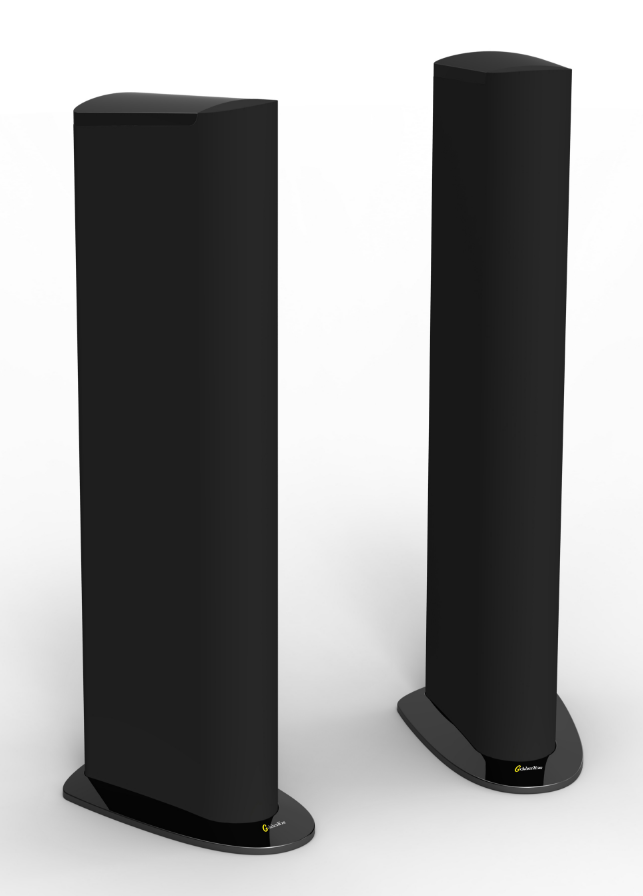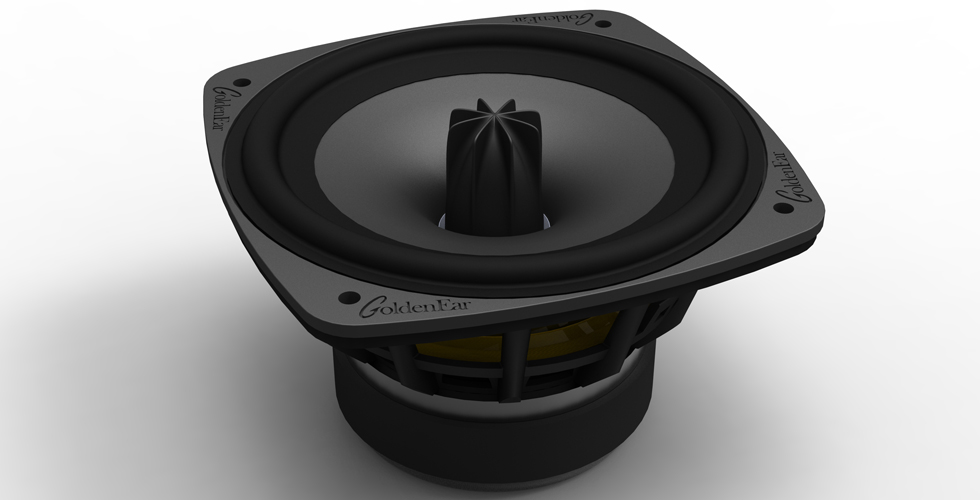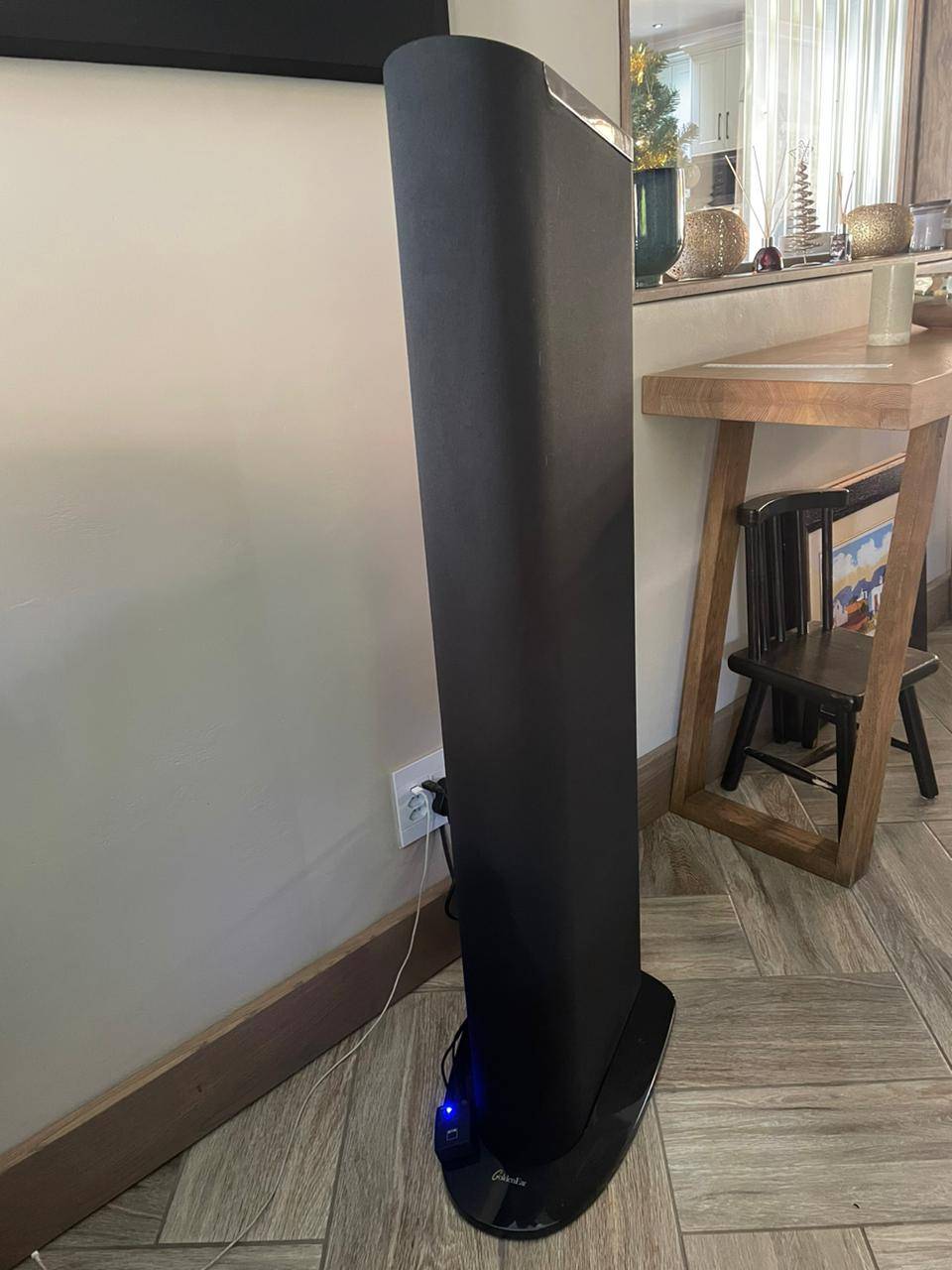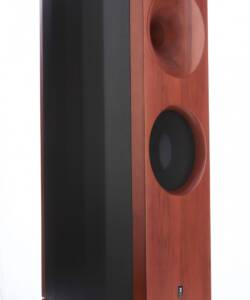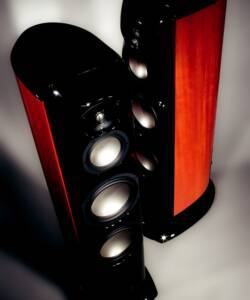GoldenEar Triton 2
Original price was: R80,000.00.R27,000.00Current price is: R27,000.00.
In a nutshell, the Triton Two offers:
· Extremely “fast” and detailed treble response, but without so much as hint of roughness, edginess, glare, or overshoot. I put this down, first and foremost, to the excellent job that GoldenEar has done with its new Heil-type tweeter, but also to the expert way in which the tweeter’s output is blended with GoldenEar’s dual, piston-type midrange drivers.
· Open, effortless midrange response, offering the best blend between piston-type midrange drivers and Heil-type tweeters that I’ve yet heard. Bluntly, the trouble with using Heil-type tweeters is that they generally sound almost too good for their own good, so that—to one degree or another—you can usually pick out textural discontinuities between the hyper-responsive Heil tweeter and the not-quite-so-responsive piston-type midrange drivers next door. The GoldenEar team, however, went to extraordinary lengths to tackle this problem, coming up with an unusually light, fast midrange driver that offers, I am told, frequency response that remains almost perfectly flat clear on up to around 20kHz (!). Of course, the midrange driver doesn’t have to go that high, but the point is that it is light and fast enough to do so, so that lower in its operating range it offers the kind of transient speed that really “clicks” with Heil-type tweeter in an astonishingly seamless way. See what I mean about God being in the details?
· Killer imaging and soundstaging. One of the very first things I noticed about the Triton Two was that it immediately produced an enormously wide and deep soundstage in my room, yet was also capable of very tightly focused imaging. If you buy these speakers, expect to be wowed by their spatial characteristics, but also plan on spending a fair amount of time dialing-in their position in your room to get a just-right combination of stage width and depth vis-à-vis image specificity and focus. Depending on where/how you place the Triton Twos, I found that it was possible to get more of one quality (stage size) at the expense of the other (image specificity), so that it is important to take your time and to find an optimally realistic compromise. One further note is that the Triton Two tends, for whatever reason, to cast an image that floats at or even a bit above the tops of the towers, which I found very realistic (true, it’s not quite the same as the floor-to-ceiling image presentation that you get with Magnepans, but it’s not too far off from that standard).
· Resolution to rival the big boys. The Triton Two offer plenty of detail and resolution, though in a casual, naturalistic, and almost “offhand” way—this in contrast to, say, MartinLogan speakers, where details tend in a sense to draw attention to themselves (albeit in a breathtakingly pure and focused way).
· Real live, no jive, full-range bass. The Triton Two goes very, very low, and with real authority. This is, however, something of a double-edged sword, in that not all rooms can deal with speakers that can provide significant bass output below 30Hz.
· Very good woofer-to-midrange driver integration. The Triton Two does a much better than average job of handling the tricky region where output from the woofers and the midrange drivers must blend. GoldenEar’s DSP-controlled woofer amp section really helps out here, I think. Even so, great two-way speakers (e.g., the YG Carmels) can in my opinion handle the transition from upper bass to lower midrange frequencies even more coherently than the Triton Twos do.
· Terrific flexibility and ease of use. Unlike most other speakers capable of such high overall levels of sound quality, the Triton Twos are capable of playing quite loudly, yet are ridiculously easy to drive. This is true in large part because the entire woofer section of the speaker is self-powered. Thus, your amp never really has to drive the woofers; instead, it has only to drive the input section of the subwoofer amp. What does this buy you? Well, for starters it means you can use pretty much any type of amp you wish, yet get consistently good results. You could, for example, quite reasonably choose to drive the Triton Twos with a small, low output tube amp , yet without sacrificing serious bass performance (something you could never, ever do with, say, the Magnepan MG1.7’s). While the Triton Two’s sound fine when driven by high-powered amps, they in no way require them, which is an important distinction to grasp. But here’s a further observation: the Triton Two is one of the very few true audiophile-grade speakers that would also be perfectly at home in a high-end home theater context—where, please note, the Triton Two would absolutely not require separate subwoofers (because the subwoofers are already built in—cool, no?).
I believe the GoldenEar Triton Two will in due time earn a reputation as a watershed product, largely because it places very high-level sound quality within reach for those of us who must operate within the often tight constraints of real-world, Everyman budgets. I also suspect the Triton Two will serve as a thrown gauntlet of sorts vis-à-vis any number of high-end poseurs, forcing them either to put up, shut up, or figure out a way to deliver greater performance per dollar. And from my point of view, that’s a wonderful thing.
Sound
I think of loudspeakers—and of audio systems in general—as potentially providing two sorts of sonic illusion: transporting me to the concert hall or recording studio in which the recording was made (“I am there”), and bringing the performers into my listening room (“They are here”). The Triton Twos were able to conjure up both, but were particularly adept at the first. Listening to Live, a familiar disc of 10 operatic arias and duets recording in concert with Luciano Pavarotti and Mirella Freni (CD, London 421 862-2), I found that, with my eyes closed, it was easy to imagine that I was at that concert, sitting well back from the stage, the voices precisely focused in space with a quite stunning sense of realism—and this is by no means an audiophile recording.
The “General Image and Resolution Test” on the Chesky Jazz Sampler & Audiophile Test CD, Vol.2 (JD68) has four musicians entering a church, playing a shaker, maraca, hand drum, and wooden block. They march around, circling the microphone three times, playing their instruments, whooping and hollering along the way. It’s a lot of fun, even if it isn’t great music. Played at a realistic level (ie, fairly loud), this recording was almost scary in its presence, the sound of these percussion instruments precisely located in space and the movements of the musicians unambiguous in their clarity—at one point the musicians seemed to cross the room behind me, producing the “They are here” illusion.
This is outstanding performance for any loudspeaker, particularly one with a relatively modest price. The soundstage was quite high: more than a foot above the 48″-high top of the speakers, which is just the way I like it. Depth was dependent on the recording, but didn’t seem to be limited by the speakers. Playing the image depth test from the Chesky disc, which has clickers recorded from 5′ to 70′ from the mike, I could hear clear differentiations between the clicks recorded at 50′, 60′, and 70′. This is as good as or better than I’ve heard from any speakers in my room.
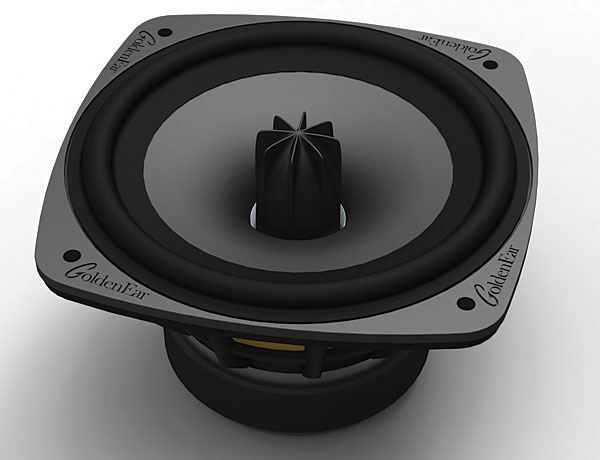
In terms of tonal balance, the Triton Two was pretty well spot-on, neither emphasizing nor neglecting any part of the frequency range. Ribbon tweeters have a reputation for being highly detailed but tending toward extra brightness, as I’d found with the ribbon of the Monitor Audio Platinum PL200 (see my review in the April 2010 issue). However, GoldenEar’s folded-ribbon tweeter was detailed without sounding too bright. Treble emphasis can show up in a variety of ways, the most annoying for me being a hardening of vocal sibilants. Thankfully, this problem was absent with the Triton Two, except for recordings that were miked too closely and/or used microphones with a pronounced treble peak. If anything, the highs were a touch on the soft, sweet side.
The Triton Two’s midrange was fundamentally neutral. For me, the most important test of midrange neutrality is the reproduction of voices. Some people can tell whether a pianist is playing a Steinway or a Bîsendorfer, or whether a violin is a Stradivari or a Guarneri. I can’t—and as long as I like the music and the musician’s playing, I don’t really care about the instrument. (Well, within reason.) But each human voice is unique, and I want a speaker (and, of course, the rest of the system) to maintain each voice’s unique timbre. Sometimes I’m familiar with a singer’s voice from live performances, which provides a point of reference. In those cases, the Triton Two was uncommonly successful at producing sounds that resembled what I remembered hearing from the singer in concert.
Rod Gilfry is a baritone whose repertoire ranges from Mozart to Sondheim, and, unlike most opera singers, he sings musicals with the appropriate style and vocal production, not afraid to sing softly when the material requires it. I heard him last summer as Frank Butler in a production of Annie Get Your Gun at the Glimmerglass Festival, a production that also starred the great dramatic soprano Deborah Voigt in a charming performance that did not for a moment sound like a slumming opera diva. Gilfry sounded great, singing with appropriate swagger in “I’m a Bad, Bad Man,” and romantic tenderness in “The Girl That I Marry.” I bought his recording My Heart Is So Full of You (CD, Narratus Productions 07), and when I played it at home, I was struck by how much the sound of his voice resembled what I had heard from the Glimmerglass stage. (Look for this recording in my “Records To Die For” listing elsewhere in this issue.) Sylvia McNair is another opera singer who can manage to not sound like one; her album Sure Thing (CD, Philips 442 129-2), featuring the music of Jerome Kern, is a longtime favorite of mine, and though I haven’t heard McNair live, listening to this disc through the Triton Twos, I had the feeling that this is just what she must sound like in person.
Another major strength of the Triton Two was its bass: extended and powerful to a degree that was hard to credit to such modestly sized enclosures, with a good match of the low to midbass. For speakers of this size, regardless of the driver complement, I normally expect in-room bass extension to 40Hz, or a few Hz lower if you have a room mode that boosts the lower frequencies. GoldenEar Technology claims 16Hz for the Triton Two; that may be a bit optimistic, but still, the speaker’s bass extension was impressive. With the subwoofer level adjusted to produce the most optimal match with the rest of the audioband, bass drums and organ-pedal notes came over with authority, and string basses were neither lightweight nor overemphasized (apart from a 50Hz emphasis that I’ve found with a number of speakers, and which I believe is a room mode). When I tested with the low-frequency tones on Nordost Corporation’s System Set-Up & Tuning Disc (CD, Nordost CD NOR 101), the 24Hz note was clearly there, 21Hz was weaker but still audible, but 18Hz was not. I’ll be interested in John Atkinson’s measurements of the Triton Two’s bass extension.
Depending on the amplifier driving it, the Triton Two could play loud without sounding discomfited. As expected, the 150Wpc Simaudio W-7 amplifier was the best performer in this respect, but the Audiopax and PrimaLuna amps were both able to drive the GoldenEars to levels as high as I would want. Eiji Oue and the Minnesota Orchestra’s recording of Mussorgsky-Ravel’s Pictures at an Exhibition (HDCD, Reference RR-79CD) came across with real authority, the bass drum and organ providing an underpinning that’s merely hinted at by speakers lacking the bottom octave. Even though the Triton Two’s subwoofer has its own amplifier, it sounded different depending on the main amplifier being used, the Simaudio producing the tightest, most extended bass. By contrast, the two tube amplifiers, especially the Audiopax, were ahead in terms of harmonic accuracy.
As well as having more-than-respectable high-level dynamics, the Triton Two also excelled at microdynamics: the music’s subtle ebb and flow. I greatly admire the musicianship of Sylvia McNair and André Previn on Sure Thing. McNair is at one with the music and lyrics, and Previn gives a lesson in the art of accompaniment. In a number like “The Folks Who Live on the Hill,” the interplay of singer and pianist is exquisite, and I was able to follow it all easily through the Triton Twos.
Is it possible for a speaker (or other audio component) to be too detailed, to have too much resolution? I’ve seen this question debated in audio forums; my answer is No—with some qualifiers. In general, I want a speaker that lets me hear more of the music that’s encoded in the digital data or in the LP groove, but that may also let in more of the noise, and if that noise (ie, nonmusical sounds) is too prominent, then it becomes difficult to enjoy the music. There are speakers on the market that have a reputation for being highly detailed, of being able to resolve the tiniest of differences, but that are rejected by many audiophiles, who find them too fatiguing to listen to in the long run. At the other end of the spectrum are speakers that have an easy-on-the-ears, “musical” tonal balance, but are weak at resolving the music’s fine detail.
Whether by deliberate decision or as a byproduct of component choices and other aspects of the design process, the Triton Two maintained a high level of resolution while never sounding hyperresolving or clinical. There’s a point about five seconds into Ciläa’s “Lamento di Federico,” from Mario Lanza’s Live from London (CD, RCA 61884-2), at which someone—perhaps Lanza himself—hums a note that’s part of Constantin Callinicos’s piano introduction. The note is faint, but it’s there, and the Triton Two let me hear it. Through the Triton Two it was also easy to hear the effects of various system tweaks, such as Nordost’s Platinum Sort Kones vs the wooden blocks under my Ayre Acoustics CX-7eMP CD player.

I’ve tried to catalogue the Triton Two’s many sonic virtues, but I would be remiss if I didn’t mention that it had one characteristic that sometimes detracted from the illusion of the sound being produced by actual musicians and singers in my room. Some “box” colorations sometimes made me aware that I was listening to speakers. These were mostly when music was being played quite loud, and were more apparent when I listened from off axis rather than in the sweet spot. This was by no means a deal-breaker, and it was evident only occasionally, but this is one area of performance in which the Triton Two could be improved. At what price that improvement, however, is a different question. Speaker manufacturers like Wilson Audio, Hansen, YG Acoustics, and Magico have gone all out in their efforts to subdue box colorations, but their speakers are in a price range an order of magnitude higher than the Triton Two’s!
Comparisons
The last two speakers I reviewed were the Monitor Audio Platinum PL200 ($8000/pair, April 2010) and the Focal Chorus 826W Anniversary Edition ($3495/pair, November 2010), both floorstanders of about the same size as the Triton Two. The obvious question was how the GoldenEars Triton Two would compare with these more expensive speakers.
Not an easy question to answer. The Monitors and Focals were returned to their distributors some time ago, so I wasn’t able to make direct comparisons with the GoldenEars. Although I don’t think auditory memory is quite as unreliable as some people claim, I wouldn’t want to bet the farm on the accuracy of my recollection of sounds I heard a year ago. Perhaps an even greater problem is presented by subsequent changes in my system. Since I reviewed the PL200 and Chorus 826W, I have replaced PS Audio’s Power Plant Premier AC regenerator with their PerfectWave Power Plant 5, now use Nordost Platinum Sort Kones rather than wood blocks under the Ayre CX-7eMP, and have substituted a Hi-Fi Tuning Supreme fuse for the stock fuse in the CAT SL-1 Renaissance preamp. These changes add up to a very significant overall sonic improvement that would present a confounding variable for comparisons with the Triton Two even if my auditory memory were perfect. This is not a copout, but reality.
But there are a few things I can say without going out too far on a limb. Of the three speakers, the Triton Two had by far the most extended and powerful bass. The ported woofers of the PL200 and the Chorus 826W, while certainly respectable in their performance, simply couldn’t match the bass from the powered built-in subwoofer of the Triton Two.
As for the more subtle and subjective aspects of sound quality, and for the moment putting aside the confounding variables of system changes, the GoldenEar was very much in the same sonic league as the other two speakers, the Monitor having perhaps a notch higher resolution, at the cost of a touch of brightness. In soundstage depth and width and precision of imaging, the Triton Twos were easily a match for the other two speaker pairs—neither of which is exactly a slouch in this department.
Judgments of a product’s appearance are also subjective, but the Monitor Audio Platinum PL200, with its hand-rubbed wood veneer, was the most beautiful of the three to my eye, though I find the Triton Two attractive as well. But if you want your speakers to look like pieces of furniture, the PL200—and, to a lesser extent, the Focal Chorus 826W—will be more to your taste.
I was able to directly compare the Triton Two with my reference speaker, the Avantgarde Uno Nano, a horn hybrid with a powered subwoofer ($17,000/pair when last available; the German company is currently having problems with North American distribution). The Uno Nano is, overall, the “better” speaker: it’s able to produce the illusion of live music more successfully than the Triton Two, with high-level dynamics that the GoldenEar can’t match. This, of course, comes at a cost: you could buy six pairs of Triton Twos for the price of a pair of Uno Nanos, and still have money left over for some really good interconnects. But if price is not a deterrent, the Avantgardes will give you a closer approximation of live music.
The fact is, I was quite content to listen to music through the Triton Twos. In my high-end system, whose speaker cables cost more than the GoldenEars, there was no indication that the speakers were a weak link in the chain. I was in no hurry to switch back to my Avantgardes.
Conclusions
Given the technology that these speakers represent, not to mention their sound quality, I would not be surprised if they retailed at around $10,000/pair. But they cost only a fourth of that: $2499.98/pair. I don’t know how GoldenEar can sell the Triton Two at that price and still make money for themselves and their dealers. Having the speaker being made in China certainly helps—but nowadays most speakers, even ones with pedigreed names, are made there. Sandy Gross wrote, in an e-mail, “We lavish the same care, expertise and experience that is usually reserved for the highest-priced high-end speakers on every GoldenEar speaker we create. We do it because we can—and because we know that you will enjoy and appreciate the result.”
Finally, a caveat about auditioning these speakers at a dealer: The Triton Twos’ relatively low price means that dealers will likely combine them with electronics and source components of similarly modest prices. This will not bring out these speakers’ best. One audiophile told me that he’d heard the Triton Twos at a dealer driven by a midpriced home-theater receiver (with who-knows-what source) and was not that impressed with the sound. I’m not surprised. A speaker can reproduce only the signal it’s fed; if you give it a mediocre signal, it can produce, at best, mediocre sound. The Triton Two is good enough to deserve associated equipment of high quality—which doesn’t necessarily mean high price. Combine it with something like a PrimaLuna ProLogue Premium integrated amp, an Oppo BDP-95 universal Blu-ray player, and Nordost Leif cables, and you have a seriously good system for less than $7000 that will take you through these recession-prone times.
Description
Speaker: Triton Two
Type: Three-way, tower
Tweeter (size in inches, type): 1×1.33, kapton HVFR ribbon
Midrange (size in inches, type): 4.5, polypropylene cone (2)
Woofer (size in inches, type): 5×8, polypropylene cone (2), 4.5, polypropylene cone (2), 4.5, polypropylene cone (2)
Nominal Impedance (ohms): 8
Recommended Amp Power (watts): 20–500
Available Finishes: Black
Dimensions (W x H x D, inches): 7.5 x 48 x 15
Weight (pounds): 60



